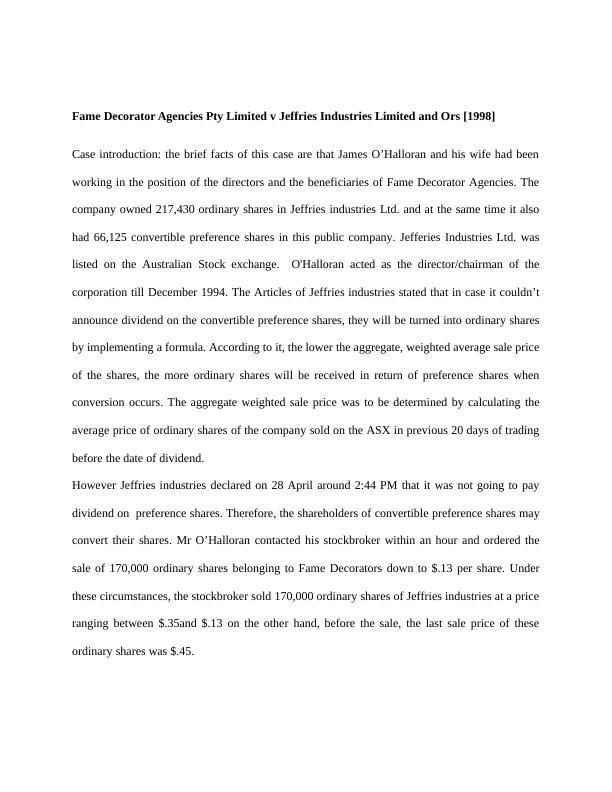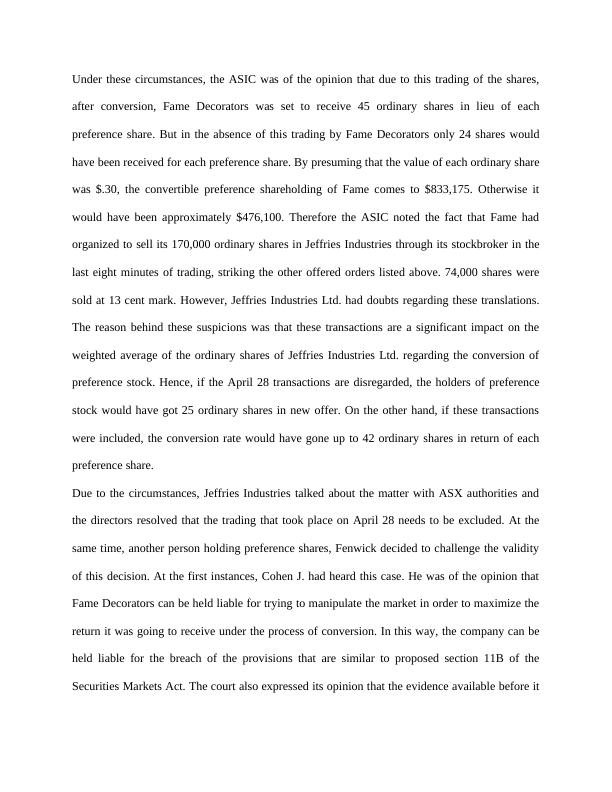Ask a question from expert
Fame Decorator Agencies Pty Limited v Jeffries Industries Limited and Ors
7 Pages2017 Words223 Views
Added on 2020-04-01
Fame Decorator Agencies Pty Limited v Jeffries Industries Limited and Ors
Added on 2020-04-01
BookmarkShareRelated Documents
Fame Decorator Agencies Pty Limited v Jeffries Industries Limited and Ors [1998]Case introduction: the brief facts of this case are that James O’Halloran and his wife had beenworking in the position of the directors and the beneficiaries of Fame Decorator Agencies. Thecompany owned 217,430 ordinary shares in Jeffries industries Ltd. and at the same time it alsohad 66,125 convertible preference shares in this public company. Jefferies Industries Ltd. waslisted on the Australian Stock exchange. O'Halloran acted as the director/chairman of thecorporation till December 1994. The Articles of Jeffries industries stated that in case it couldn’tannounce dividend on the convertible preference shares, they will be turned into ordinary sharesby implementing a formula. According to it, the lower the aggregate, weighted average sale priceof the shares, the more ordinary shares will be received in return of preference shares whenconversion occurs. The aggregate weighted sale price was to be determined by calculating theaverage price of ordinary shares of the company sold on the ASX in previous 20 days of tradingbefore the date of dividend.However Jeffries industries declared on 28 April around 2:44 PM that it was not going to paydividend on preference shares. Therefore, the shareholders of convertible preference shares mayconvert their shares. Mr O’Halloran contacted his stockbroker within an hour and ordered thesale of 170,000 ordinary shares belonging to Fame Decorators down to $.13 per share. Underthese circumstances, the stockbroker sold 170,000 ordinary shares of Jeffries industries at a priceranging between $.35and $.13 on the other hand, before the sale, the last sale price of theseordinary shares was $.45.

Under these circumstances, the ASIC was of the opinion that due to this trading of the shares,after conversion, Fame Decorators was set to receive 45 ordinary shares in lieu of eachpreference share. But in the absence of this trading by Fame Decorators only 24 shares wouldhave been received for each preference share. By presuming that the value of each ordinary sharewas $.30, the convertible preference shareholding of Fame comes to $833,175. Otherwise itwould have been approximately $476,100. Therefore the ASIC noted the fact that Fame hadorganized to sell its 170,000 ordinary shares in Jeffries Industries through its stockbroker in thelast eight minutes of trading, striking the other offered orders listed above. 74,000 shares weresold at 13 cent mark. However, Jeffries Industries Ltd. had doubts regarding these translations.The reason behind these suspicions was that these transactions are a significant impact on theweighted average of the ordinary shares of Jeffries Industries Ltd. regarding the conversion ofpreference stock. Hence, if the April 28 transactions are disregarded, the holders of preferencestock would have got 25 ordinary shares in new offer. On the other hand, if these transactionswere included, the conversion rate would have gone up to 42 ordinary shares in return of eachpreference share.Due to the circumstances, Jeffries Industries talked about the matter with ASX authorities andthe directors resolved that the trading that took place on April 28 needs to be excluded. At thesame time, another person holding preference shares, Fenwick decided to challenge the validityof this decision. At the first instances, Cohen J. had heard this case. He was of the opinion thatFame Decorators can be held liable for trying to manipulate the market in order to maximize thereturn it was going to receive under the process of conversion. In this way, the company can beheld liable for the breach of the provisions that are similar to proposed section 11B of theSecurities Markets Act. The court also expressed its opinion that the evidence available before it

cannot be treated as the sufficient evidence to support the argument of Fame related with thepresence of an immediate selling obligation present on part of the company behind thediscounted selling of the shares. In this regard, it was stated by the court that Fame could havearranged the finance from other resources. Due to this situation, the trial court concluded that thetransaction was not caused by general supply and demand but they were made by the seller whowas not affected by general demand.The duties/responsibilities breached: But while deciding this case, Cohen J had made an arbitrarydistinction. So the court affirmed that the sales at 25 cents were not a breach because they werenot too much of a low price, while the sales at 14 and 13 cents were. On the reason of thisdistinction, the single sale of $170,000 have been either split into two purposes. While one ofthese purposes was legitimate, the other was considered as the manipulation or in other words, orthe sale had multiple effects, while one effect was misleading, the other was not. As a result, an appeal was made. It was contended that the conduct of Fame cannot be mentionedas misleading or deceptive. Hence, it cannot be said that the transaction amounted to themanipulation of the market. But Fame Decorators also accepted that the conduct can indeed beopportunistic taking advantage of the situation. But at the same time, the company also arguedthat it was not responsible for the fact that such a situation has been created. However, the appealwas rejected by majority of the Court of Appeal. The court stated that the equivalent to s11B,cannot be treated as only being confined to cases of fictitious trading. On the other hand, PriestlyJ. Give a judgment in dissent. He was not ready to accept the majority opinion which claims thatthe arm's-length translations according to seats method cannot be considered as demand andsupply. Therefore, he was not easy with the fact of imposing liability for demand regulation of

End of preview
Want to access all the pages? Upload your documents or become a member.
Related Documents
Case of Fame Decorator Agencies Pty Limited v Jeffries Industries Limitedlg...
|7
|2170
|90
Fame Decorator Agencies Pty Ltd v Jeffries Industries Ltd Assignmentlg...
|9
|2758
|173
Overview of Company Law Assignmentlg...
|10
|2099
|106
The Australian case of Decorator Agencies Pty Ltd v Jeffries Industries Ltdlg...
|12
|2750
|178
Assignment on Business Law Jefferies Industries Limitedlg...
|12
|3088
|56